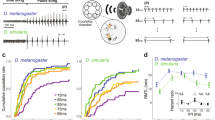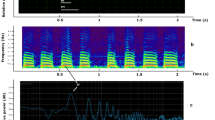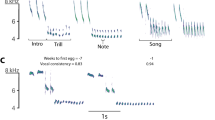Abstract
THE songs of most insect species are stereotyped and show regular rhythms1,2 which can be readily defined and described. In such cases, closely related species produce songs which differ in rhythmic structure3–5, carrier frequency5,6 or combinations of these parameters3,7. We have examined the songs produced during courtship of the sibling drosophilid fly species Zaprionus tuberculatus, Z. sepsoides and Z. mascariensis which are known from morphometric8 and chromosomal evidence to be closely related. Drosophilid songs are produced by wing beating and normally consist of a regular series of similar mono- or polycyclic sound pulses with carrier frequencies of 150 to 500 Hz and pulse periods of 8 to 250 ms (for review, see ref. 9). Some species produce more than one type of song, and the pulsed song may be interrupted by protracted bursts of constant frequency tone10.
This is a preview of subscription content, access via your institution
Access options
Subscribe to this journal
Receive 51 print issues and online access
$199.00 per year
only $3.90 per issue
Buy this article
- Purchase on Springer Link
- Instant access to full article PDF
Prices may be subject to local taxes which are calculated during checkout
Similar content being viewed by others
References
Dumortier, B. in Acoustic Behaviour of Animals (ed. Busnel, R-G.) 346–372 (Elsevier, Amsterdam, 1963).
Alexander, R. D. A. Rev. Ent. 12, 495–526 (1967).
Leroy, Y. Bull. biol. Fr. Belg. 100, 1–134 (1966).
Ewing, A. W. & Bennet-Clark, H. C. Behaviour 31, 288–301 (1968).
Walker, T. J. Ann. ent. Soc. Am. 62, 752–726 (1969).
Bennet-Clark, H. C. Proc. R. ent. Soc. Lond. B 39, 125–132 (1970).
Ulagaraz, S. M. Ann. Ent. Soc. Am. 69, 299–306 (1976).
Tsacas, L. et al. Ann. Soc. ent. Fr. (N.S.) 13, 391–415 (1977).
Bennet-Clark, H. C. Verh. dt. zool. Ges. 1975, 18–28 (1975).
von Schilcher, F. Anim. Behav. 24, 18–26 (1976).
Bennet-Clark, H. C. Drosoph. Inf. Serv. 49, 127–128 (1973).
Pearson, E. S. & Hartley, H. O. eds Biometrika Tables for Statisticians 2, section 8 (Cambridge University Press, Cambridge, 1972).
Waldron, I. Science 144, 191–193 (1964).
Bennet-Clark, H. C. & Ewing, A. W. Anim. Behav. 17, 755–759 (1969).
von Schilcher, F. Anim. Behav. 24, 622–625 (1976).
Krebs, J. R. Anim. Behav. 25, 475–478 (1977).
Marler, P. in Simpler Networks and Behaviour (ed. Fentress, J. C.) 314–329 (Sinauer Associates, Sunderland, Mass., 1976).
Ewing, A. W. Rev. comp. Anim. 4, 3–8 (1970).
Wyman, R. J. in Simpler Networks and Behaviour (ed. Fentress,J. C.) 153–166 (Sinauer Associates, Sunderland, Mass., 1976).
Ewing, A. W. J. comp. Physiol. 119, 249–265 (1977).
Author information
Authors and Affiliations
Rights and permissions
About this article
Cite this article
BENNET-CLARK, H., LEROY, Y. Regularity versus irregularity in specific songs of closely-related drosophilid flies. Nature 271, 442–444 (1978). https://doi.org/10.1038/271442a0
Received:
Accepted:
Issue Date:
DOI: https://doi.org/10.1038/271442a0
This article is cited by
-
Secondary courtship songs and inhibitory songs ofDrosophila virilis-group males
Behavior Genetics (1994)
Comments
By submitting a comment you agree to abide by our Terms and Community Guidelines. If you find something abusive or that does not comply with our terms or guidelines please flag it as inappropriate.



